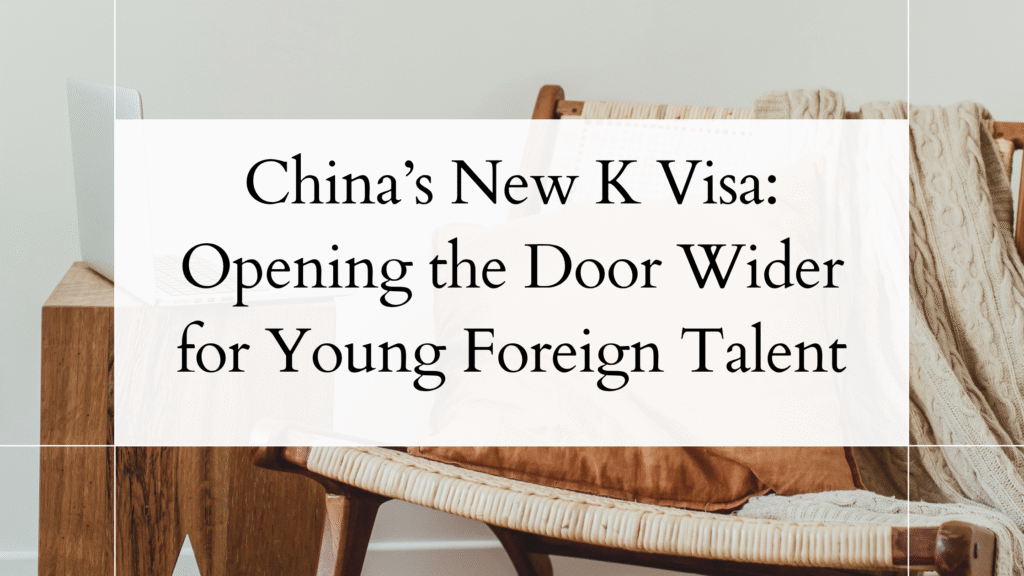
China’s newly revised entry-exit regulation introduced a new K visa policy, effective October 1, 2025. This opens the door to young foreign science and tech talent with greater flexibility and fewer barriers. This article explains the policy changes, their background, and what they could mean for China’s innovation landscape.
What has changed?
Before this revision, China’s 2013 Foreigners Entry-Exit Administration Regulations recognized 12 categories of ordinary visas, covering purposes like work (Z visa), study (X visa), business (M visa), and family reunion (Q visa). The amendment makes two main changes:
- A New Visa Category — Article 6 now includes: “(6) K visa: issued to foreign young science and technology talent entering China.”
- Application Requirements — Article 7 now specifies: “Applicants for a K visa must meet the conditions and requirements for foreign young science and technology talent stipulated by the relevant Chinese authorities and submit corresponding supporting documents.”
The definition of “young science and technology talent” is quite specific:
- Graduates in STEM (science, technology, engineering, mathematics) fields from recognized universities or research institutions worldwide, holding at least a bachelor’s degree; or
- Young professionals engaged in relevant education or research work at such institutions.
Why now? The policy background
The introduction of the K visa ties directly to national strategic priorities outlined in the 20th National Congress report:
- “Science is the primary productive force, talent is the primary resource, and innovation is the primary driver.”
- The Talent Power Strategy calls for “more proactive, open, and effective” policies to attract international talent.
With the global race for scientific and technological leadership intensifying, China is making an explicit play for the next generation of innovators. The K visa is an instrument for:
- Lowering barriers to entry for qualified individuals;
- Enhancing international exchange in science and technology; and
- Fostering collaboration that feeds into China’s innovation ecosystem.
How the K visa differs from existing options
Compared with existing visa types for work or research, the K visa offers:
- More flexibility: No requirement for a Chinese employer or inviter at the application stage.
- Convenience: Potentially more generous terms for entry frequency, validity period, and duration of stay.
- Breadth of permitted activities: Holders can engage in education, research, cultural exchange, entrepreneurship, and business.
In practice, this makes it more appealing to fresh graduates, independent researchers, and entrepreneurs who might not yet have formal job offers in China but want to explore opportunities.
Implications for China’s talent landscape
Boosting Early-Career Talent Flow
Most immigration systems favor experienced professionals with long CVs. The K visa takes a different angle, aiming at youth — those in the formative stages of their careers. That means China is not just importing skills, but also building long-term relationships that may yield decades of collaboration.
Supporting innovation ecosystems beyond Beijing and Shanghai
While top-tier cities will be obvious magnets, the flexibility of the K visa could benefit smaller innovation hubs — for example, provincial tech parks, biotech clusters, or AI startups — that previously struggled to attract foreign talent due to cumbersome entry requirements.
Signaling openness amid global competition
At a time when some countries are tightening immigration, China is sending a different signal: Qualified talent is welcome here. This could enhance China’s “soft power” among global youth in the science and technology fields.
Potential for reverse brain drain
For Chinese nationals studying or working abroad who have foreign citizenship, the K visa provides an easier route to return temporarily for projects, teaching, or business ventures.
Potential challenges and considerations
- Defining “young” and “talent”: The initial guidelines point to age and academic background, but these criteria will need fine-tuning to avoid excluding capable candidates from non-traditional career paths.
- Integration and retention: Entry is just the first step. To truly benefit, China will need policies that help K visa holders integrate socially and professionally.
- Balancing security with openness: Science and technology are sensitive sectors; managing intellectual property and security concerns will be critical.
- Avoiding bureaucratic bottlenecks: Even with simplified requirements, efficiency in visa processing will determine whether the K visa’s potential is realized.
